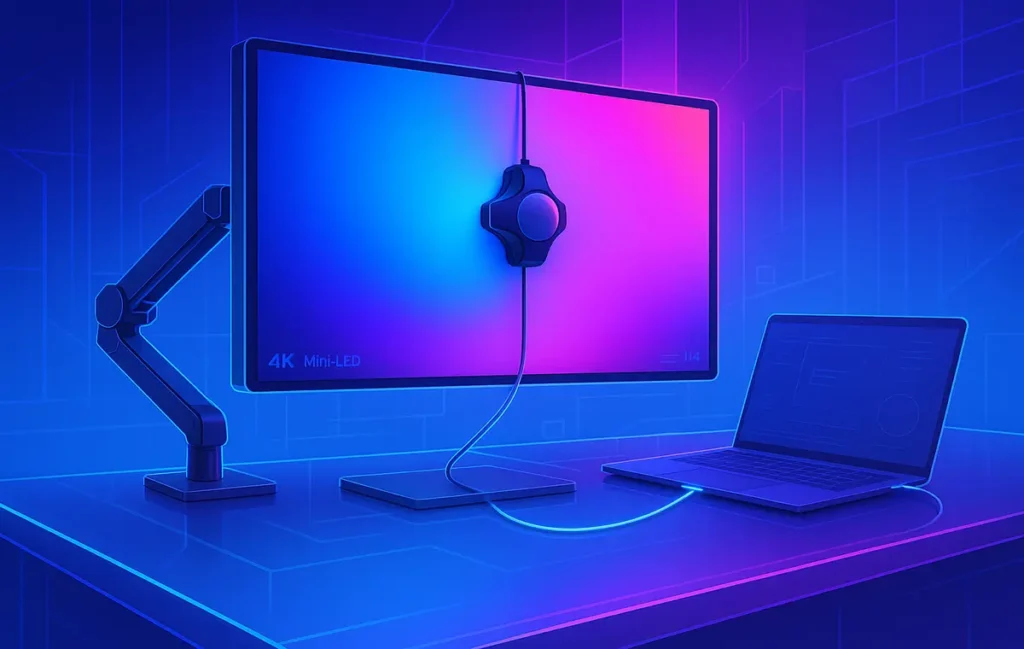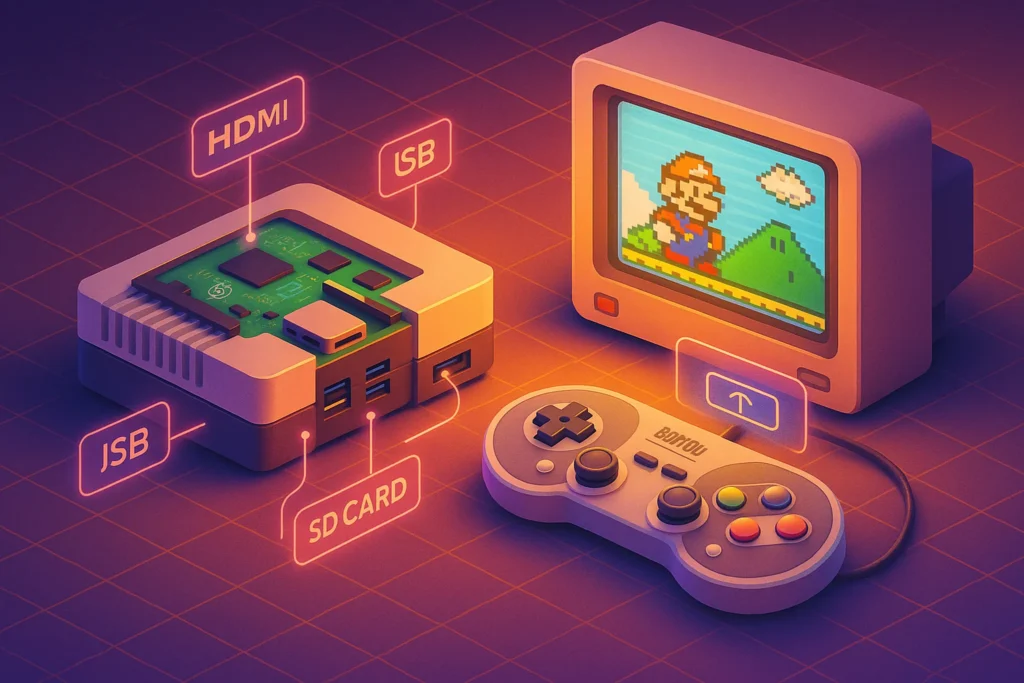🎯 Intro: Your Monitor Is a Creative Instrument, Not a TV
For designers, editors, illustrators, and photographers, a display is the canvas, the loupe, and the reference window—all at once. If the panel is mediocre, your colors drift, your retouching lies to you, and your grade doesn’t translate to the client’s screen. If it’s overkill in the wrong ways, you overspend on specs that don’t move the needle. This NerdChips guide cuts through the buzzwords so you can choose a high-resolution monitor that matches your workflow, your color expectations, and your budget—and stays relevant as software, codecs, and OSes keep pushing pixels harder.
We’ll connect to related deep dives—like Best OLED Monitors, the LG UltraFine Evo 6K Monitor with Thunderbolt 5, compact Portable USB-C Monitors for on-set review, and even Ultra-Wide Monitors for Gaming if you’re a hybrid creator-gamer—so you can make a decision that feels good on day one and still makes sense two years from now.
💡 Nerd Tip: Before shopping, list your top three deliverables (e.g., “web design in sRGB,” “YouTube HDR,” “fine-art print”). The right panel is the one that nails your deliverables, not someone else’s dream setup.
🧠 Why High Resolution Matters (More Than Marketing)
High resolution is not just bragging rights; it’s workflow leverage. At 4K and above, vector edges and small UI elements look cleaner, which reduces eye strain during long sessions in Photoshop or Figma. On a 6K canvas, you can keep a full-size preview and 100% zoom details visible without constant window juggling—especially liberating in After Effects, Resolve, or Illustrator.
Pixel density also influences retouching precision. With more pixels per inch (PPI), you can evaluate halos, gradients, and banding more reliably, which means fewer re-exports and less second-guessing. For video, a 4K timeline on a 4K or 6K monitor helps you spot aliasing and compression artifacts that would be invisible on 1080p. And for multi-taskers, more pixels equals less tab shuffling—reference boards, sequence timelines, scopes, and source bins can coexist without feeling cramped.
None of that matters if the panel can’t render accurate color—so resolution is necessary, not sufficient. Think of it as the grid your color and tone fidelity sit on. You want both right.
💡 Nerd Tip: If you work at 100% UI scaling on 27″ 4K and feel “squint-y,” try 32″ 4K or 27″ 5K. You’ll keep sharpness but reclaim comfortable UI sizes.
🧩 Resolution & Size: Getting PPI and Working Distance Right
Choosing resolution is mostly a PPI and distance equation. At typical desk distances (55–75 cm), 27″ 4K offers a sweet spot around ~163 PPI—crisp UI and fine detail. 32″ 4K drops to ~138 PPI, which many find more legible without scaling. 5K/6K on 27–32″ climbs back toward “retina-like” density for ultra-sharp vector edges, typography, and pixel-level retouching.
Where this gets practical:
-
Photographers benefit from 4K minimum to evaluate micro-contrast and sharpening halos without constant zooming.
-
Editors benefit from 4K or 6K to view a 4K canvas, scopes, and bin windows side-by-side.
-
Designers/Illustrators see tangible gains from 5K/6K: crisp bezier curves, clean text at small sizes, and room for panels.
If you’re split between 27″ and 32″, consider your scaling preference. If you like 100% scaling, 32″ 4K is less tiny than 27″ 4K. If you love ultra-crisp UI and don’t mind 125–150% scaling, 27″ 4K or 27–32″ 5K/6K is bliss.
See how this plays with your I/O choices in our TB/USB coverage; if you’re eyeing dual 6K, study the LG UltraFine Evo 6K Monitor with Thunderbolt 5 and our TB5 explainer linked from that post.
🖼️ Panel Technologies: IPS vs OLED vs Mini-LED (What Creators Actually Feel)
IPS is the workhorse: consistent viewing angles, stable white point, predictable calibration. A good IPS with wide gamut backlight can cover 100% sRGB easily and often 98–99% DCI-P3 or 95–99% Adobe RGB in pro models. Blacks aren’t OLED-deep, but for design, photo, and a lot of video work, IPS is still the sane baseline—especially in bright rooms.
OLED brings near-infinite contrast and perfect pixel-level dimming. For color grading and HDR previews, nothing beats the shadow detail and zero blooming. You’ll see subtle tonal steps and fine color separation in dark scenes that IPS/Mini-LED can smear. Caveats: brightness can be lower on full-screen white UI, and image retention is a risk if you leave static UIs for long stretches. Creator-grade OLEDs mitigate this with pixel shifting and care modes.
Mini-LED is IPS with a turbo HDR backlight: hundreds to thousands of local dimming zones for higher full-screen brightness and strong HDR highlights with less blooming than standard IPS. For bright studios and mixed web+video work, Mini-LED scratches the “HDR punch” itch while keeping IPS stability.
💡 Nerd Tip: Choose OLED if your priority is contrast fidelity (grading, cinematic look). Choose Mini-LED if your priority is HDR brightness in bright rooms. Choose IPS if you want stable, affordable accuracy across long sessions.
🎯 Color Accuracy: Gamut, Delta-E, and Calibration Without the Mystique
If your work is destined for the web, sRGB accuracy is non-negotiable. For print, prioritize Adobe RGB. For modern video pipelines—especially HDR and DCI workflows—DCI-P3 coverage matters. Look beyond “covers P3” claims and inspect factory calibration targets and ΔE (Delta-E) metrics. A ΔE < 2 average means color errors are below just-noticeable differences for most observers; ΔE < 1 in pro modes is elite.
The factory profile should be a starting point, not a final destination. If your monitor supports hardware calibration (internal 3D LUT), you can calibrate without OS LUT compromises, preserving smoother gradients and predictable behavior across apps. Pair this with a probe from X-Rite or Datacolor for quarterly recalibrations.
Don’t forget uniformity compensation—on larger panels, edge-to-center luminance or tint variance can betray your retouching. Creator-class lines (BenQ PD/Pro, ASUS ProArt, Dell UltraSharp PremierColor) include uniformity modes to tame this.
💡 Nerd Tip: Calibrate to your delivery. Web work? 120 cd/m², D65, sRGB TRC. Print soft-proofing? 80–100 cd/m², D50 or your print house profile. HDR? Validate EOTF tracking with proper metadata playback.
🌈 HDR, Bit Depth, and Motion: What Editors and Colorists Should Check
HDR marketing is chaotic. Meaningful HDR requires sustained brightness, local dimming or emissive pixels, and correct tone mapping. Mini-LED and OLED screens do HDR credibly; standard IPS with “HDR400” badges are usually SDR-plus.
For motion, refresh rate and response times matter. Video editors benefit from 120 Hz not for gaming, but for UI fluidity, scrubbing feel, and timeline responsiveness. OLED panels lead in response time; Mini-LED/IPS have improved with overdrive but still show more motion blur.
Bit depth is another gotcha. Look for genuine 10-bit pipelines (or 8-bit + FRC implemented well). If you see banding on gradients in preview comps, it might be the panel’s effective bit depth or the OS path to the display, not your export.
💡 Nerd Tip: If HDR is your deliverable, budget for a real HDR reference path—even a smaller OLED fed by a clean HDMI/SDI chain for confidence checks—while using your 4K/6K panel for UI and scopes.
🖥️ Ready to See True Color?
Explore creator-grade 4K/5K/6K monitors with factory calibration, TB4/TB5 connectivity, and real HDR—not marketing. Pick once, trust for years.
🔌 Connectivity: TB4/5, DP 2.1, HDMI 2.1, and the Cable Reality
Ports define your desk sanity. Thunderbolt 4 remains a stable baseline: single-cable docking, dual 4K, and charging up to ~100 W. Thunderbolt 5 unlocks higher aggregated bandwidth, DP 2.1 tunneling, and up to 240 W charging when devices and cables support USB PD 3.1 EPR. If you’re planning dual 6K or triple 4K with high-speed external storage, TB5 is the cleanest route; see how that pairs with our LG UltraFine Evo 6K Monitor with Thunderbolt 5 breakdown.
DisplayPort 2.1 matters for next-gen high-refresh 4K and multi-6K topologies. HDMI 2.1 is great for 4K/120 links and console parity, but DP usually offers more flexible multi-display chaining in pro contexts.
USB-C Alt Mode is not equal to Thunderbolt; some USB-C ports carry only DP 1.4 bandwidth and limited power. Check your laptop or GPU spec sheet twice, especially if you want single-cable setups.
💡 Nerd Tip: Label your cables. Use certified TB/USB4/HDMI leads and stash the packaging or spec card. Half of “my display flickers” tickets are bad or under-spec cables.
🧑🎨 Workflow Personas (and What to Prioritize)
Photographers (Studio & Retouching): Accuracy and uniformity trump everything. A 27–32″ 4K IPS/Mini-LED with Adobe RGB coverage and hardware calibration is a safe bet. If you soft-proof regularly, target lower brightness and keep a consistent light booth. If you crave ultra-sharp UI and print-grade detail, 5K/6K earns its keep.
Video Editors (YouTube to Documentary): You want 4K or 6K for canvas + bins + scopes, solid DCI-P3 coverage, and either OLED for contrast or Mini-LED for bright-room HDR. A 120 Hz panel makes timelines feel snappier. Plan I/O around DP 2.1/TB5 if you’re going multi-monitor high-refresh.
Colorists (Short-Form to HDR): Keep a trusted HDR reference path (even a smaller OLED) and use your high-res panel as the control hub. Aim for 10-bit, stable ABL behavior (for OLED), and predictable EOTF tracking.
Designers & Illustrators: Crisp typography is life. 5K/6K on 27–32″ looks “retina-clean” for UI and vector work. IPS or OLED both work; prioritize uniformity, factory calibration, and comfortable scaling.
Hybrid Creator-Gamers: If you split time between Premiere and Cyberpunk, look at OLED for motion and contrast, or Mini-LED for bright HDR. If you prefer ultrawide layouts in your DAW plus play on weekends, our Ultra-Wide Monitors for Gaming guide explains when 34″/38″/49″ makes sense.
💡 Nerd Tip: Scratch disks matter. Fast external NVMe via TB4/TB5 keeps your OS drive clean and timelines responsive. See Best External SSDs for Gaming—the same drives excel as creator scratch.
🧾 Recommended Monitors (2025 Picks by Use)
LG UltraFine Evo 6K (TB5) – If you live in the Apple ecosystem or want dual-6K dreams on Windows AI PCs, this is the cleanest single-cable pro canvas. Color modes are well-tuned, PPI is sublime for typography and retouching, and TB5 simplifies multi-display chains. Pair with a calibrator for mission-critical print or grade work. See our focused review: LG UltraFine Evo 6K Monitor with Thunderbolt 5.
Dell UltraSharp 32 4K HDR (Mini-LED) – A value-smart workhorse for editors and designers who need high brightness, strong local dimming, and reliable factory calibration. Excellent ergonomics and ports; a great “do-most-things” panel without boutique prices.
Apple Studio Display (5K) – Still one of the sharpest 27″ canvases for macOS designers. It’s not an HDR monitor, but for UI, typography, and photo in controlled light, its 5K clarity is addictive. If you don’t need HDR, it’s a joyful daily driver.
BenQ PD Series (4K IPS) – Calibrated out of the box with useful CAD/CAM and animation modes, KVM options, and uniformity controls. A superb “first pro monitor” that doesn’t require a finance meeting. If you’re climbing from consumer panels, you’ll feel the difference immediately.
ASUS ProArt OLED (4K/32″ variants) – For editors and color-leaning creators who want OLED contrast with creator-friendly I/O and calibration options. Great for SDR and HDR previews in controlled light. Be mindful of care features to minimize image retention over years of use.
💡 Nerd Tip: If you see a “creator” monitor at a suspiciously low price, scrutinize the uniformity and calibration claims. Many cut corners there, not on resolution.
🛠️ Implementation: From Box to Color-True in One Session
Unbox with intention. Place the monitor where you get minimal glare from windows or overhead lights; OLED especially punishes reflective environments. Connect with the right cable for your desired mode (DP 2.1 for high-refresh 4K/6K chains; TB5 for single-cable desk + multi-monitor + charging). Install the vendor’s control app to access preset color modes and firmware updates.
Pick the closest native color mode to your delivery (sRGB, DCI-P3, Adobe RGB). Set brightness to your environment—many creatives land between 100–140 cd/m² for SDR work. Run a calibration pass with an X-Rite/Datacolor probe, targeting your delivery white point and TRC. Save the profile and set OS color management accordingly.
Build a simple verification ritual: a grayscale ramp for banding, a uniformity test image, and a real client project you know well. If anything looks off, tweak brightness or revisit the profile. Then save your settings as a preset on the display itself so a stray app won’t surprise you.
💡 Nerd Tip: Automate a quarterly calendar reminder called “Recalibrate + Clean Panel + Check Uniformity.” Five minutes saves you from the “why does this print look warmer?” panic.
🎨 Mini Comparison Table (Panel Feel)
| Aspect | IPS | OLED | Mini-LED |
|---|---|---|---|
| Blacks/Contrast | Good | Excellent (pixel-level) | Very good (depends on zones) |
| Brightness (full-screen) | Good | Moderate (ABL limits) | Excellent |
| HDR Impact | Modest | Strong | Strong |
| Uniformity | Good (with compensation) | Excellent center; care needed for retention | Good; may see slight haloing |
| Motion/Response | Good | Excellent | Good-Very good |
| Best For | Design, photo, all-round | Grading, cinematic, mixed | Bright studios, HDR-leaning |
🚧 Challenges & Fixes (So They Don’t Bite Later)
Color drift over time: Panels age. A quarterly calibration habit keeps you honest. For mission-critical color, prefer models with hardware LUT calibration.
Cable mysteries: If a chain underperforms—flicker, capped refresh, missing HDR—swap the cable first. Keep a labeled, known-good spare for DP and TB.
Mixed-gamut confusion: macOS and Windows color management behave differently in some apps. Test your “problem child” apps (browsers, preview tools) with known reference images, and keep a note of which apps honor ICC profiles.
HDR headaches: If HDR looks washed out, confirm OS HDR settings, app HDR toggles, and tone mapping. Many “HDR” YouTube previews are SDR masquerading as HDR.
Burn-in anxiety (OLED): Use pixel shift, auto-hide static UI, and theme variations. Most creator OLEDs include care features—turn them on.
💡 Nerd Tip: If you collaborate with a team, write a one-page Display SOP: brightness targets, white point, calibration cadence, and verification image. Consistency beats heroics.
📬 Want More Smart Creator Gear Picks?
Join our free newsletter for weekly, bias-free breakdowns on displays, AI PCs, and no-nonsense workflows—curated by NerdChips. No fluff. Just field-tested advice.
🔐 100% privacy. No noise. Just value-packed tips for creative pros.
🧠 Nerd Verdict
A monitor is an investment in trust. Resolution gives you space and clarity; panel tech and calibration give you truth. For most creatives, a calibrated 4K IPS or Mini-LED remains the value sweet spot in 2025, delivering accuracy, comfort, and longevity. If your work lives in vectors, typography, or heavy timelines, 5K/6K is not overkill—it’s ergonomic sanity. And if contrast nuance is your signature, OLED will elevate your eye instantly. Buy for your deliverables, wire it with the right ports and cables, and set a simple calibration routine. That’s the creator’s path to confidence.
❓ FAQ: Nerds Ask, We Answer
💬 Would You Bite?
If you were buying today, would you choose a calibrated 32″ 4K IPS/Mini-LED for stability, or step into 6K clarity for maximal working space?
Tell us your workflow and budget—NerdChips will map the shortlist. 👇
Crafted by NerdChips for creators and teams who want their best ideas to travel the world.



